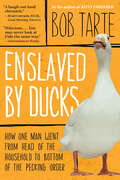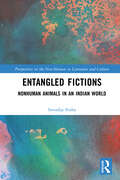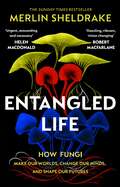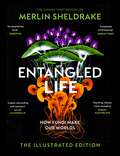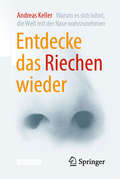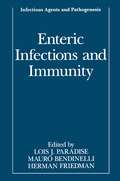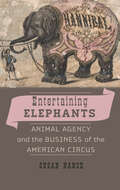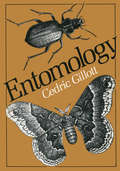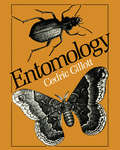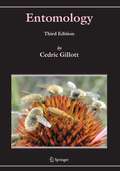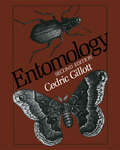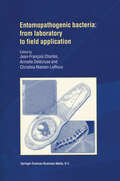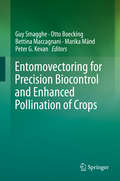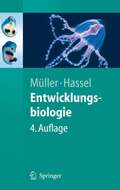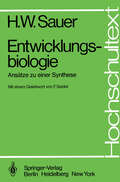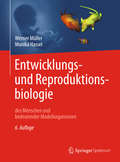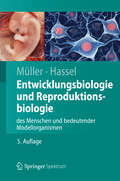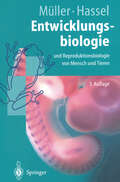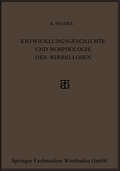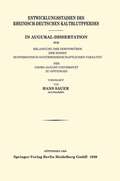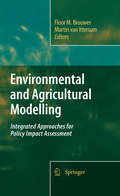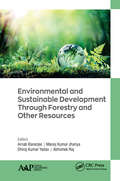- Table View
- List View
Enslaved by Ducks: How One Man Went From Head Of The Household To Bottom Of The Pecking Order
by Bob TarteThe book that Entertainment Weekly called "hilarious," Publishers Weekly declared "a true pleasure," Booklist called "heartwarming," and the Dallas Morning News praised as "rich and funny" is now available in paperback.When Bob Tarte bought a house in rural Michigan, he was counting on a tranquil haven. Then Bob married Linda. She wanted a rabbit, which seemed innocuous enough until the bunny chewed through their electrical wiring. And that was just the beginning. Before long, Bob found himself constructing cages, buying feed, clearing duck waste, and spoon-feeding a menagerie of furry and feathery residents. His life of quiet serenity vanished, and he unwittingly became a servant to a relentlessly demanding family. "They dumbfounded him, controlled and teased him, took their share of his flesh, stole his heart" (Kirkus Reviews).Whether commiserating with Bob over the fate of those who are slaves to their animals or regarding his story as a cautionary tale about the rigors of animal ownership, readers on both sides of the fence have found Tarte's story of his chaotic squawking household irresistible--and irresistibly funny.
Entangled Fictions: Nonhuman Animals in an Indian World (Perspectives on the Non-Human in Literature and Culture)
by Suvadip SinhaEntangled Fictions: Nonhuman Animals in an Indian World studies the ethical and affective relationships between human and nonhuman animals in Indian fictional worlds. While drawing upon existing theoretical and philosophical texts with nonhumanist underpinnings, Entangled Fictions argues that the corpus is limited epistemologically and politically when it comes to their examinations of the nonhuman in India. Deeply influenced by the political/existential expediencies of our times, the book traverses several genres, shifts from fictional to anecdotal, and transitions from autobiographical to spectra in effort to introduce readers to fictional worlds marked by human-nonhuman fluidity and trans-species contiguity that was imagined and lived much before the telos of human extinction became either a global or local concern.
Entangled Fictions: Nonhuman Animals in an Indian World (Perspectives on the Non-Human in Literature and Culture)
by Suvadip SinhaEntangled Fictions: Nonhuman Animals in an Indian World studies the ethical and affective relationships between human and nonhuman animals in Indian fictional worlds. While drawing upon existing theoretical and philosophical texts with nonhumanist underpinnings, Entangled Fictions argues that the corpus is limited epistemologically and politically when it comes to their examinations of the nonhuman in India. Deeply influenced by the political/existential expediencies of our times, the book traverses several genres, shifts from fictional to anecdotal, and transitions from autobiographical to spectra in effort to introduce readers to fictional worlds marked by human-nonhuman fluidity and trans-species contiguity that was imagined and lived much before the telos of human extinction became either a global or local concern.
Entangled Life: How Fungi Make Our Worlds, Change Our Minds and Shape Our Futures
by Merlin Sheldrake'A dazzling, vibrant, vision-changing book. I ended it wonderstruck at the fungal world. A remarkable work by a remarkable writer' Robert Macfarlane, author of UnderlandThe more we learn about fungi, the less makes sense without them.Neither plant nor animal, they are found throughout the earth, the air and our bodies. They can be microscopic, yet also account for the largest organisms ever recorded. They enabled the first life on land, can survive unprotected in space and thrive amidst nuclear radiation. In fact, nearly all life relies in some way on fungi. These endlessly surprising organisms have no brain but can solve problems and manipulate animal behaviour with devastating precision. In giving us bread, alcohol and life-saving medicines, fungi have shaped human history, and their psychedelic properties have recently been shown to alleviate a number of mental illnesses. Their ability to digest plastic, explosives, pesticides and crude oil is being harnessed in break-through technologies, and the discovery that they connect plants in underground networks, the 'Wood Wide Web', is transforming the way we understand ecosystems. Yet over ninety percent of their species remain undocumented. Entangled Life is a mind-altering journey into a spectacular and neglected world, and shows that fungi provide a key to understanding both the planet on which we live, and life itself.'One of those rare books that can truly change the way you see the world around you. Astounding' Helen MacDonald, author of H Is for Hawk'Reads like an adventure story ... wondrous ... beguilingly weaves together lived experience and scientific research' Sunday Times'Brilliant ... entrancing ... when we look closely [at fungi], we meet large, unsettling questions ... Merlin Sheldrake ... carries us easily into these questions with ebullience and precision ... challenging some of our deepest assumptions ... A 'door-opener' book is one with a specialist subject in which it finds pathways leading everywhere ... Sheldrake's book is a very fine example' Guardian'Mind-boggling... [Sheldrake] is nothing if not a participatory researcher into his subject and one with a winning sense of humour... it might be a good time to give thanks for this humble lifeform's effect on our lives... It's tempting... to see fungi as the biological model for a better world' Telegraph*****
Entangled Life (The Illustrated Edition): A beautiful new gift edition featuring 100 illustrations for Christmas 2023
by Merlin SheldrakeThe smash-hit Sunday Times bestseller now illustrated with over 100 spectacular full-colour images, showcasing this wondrous and wildly various lifeform as never before'Astonishing ... it seems somehow to tip the natural world upside down' Observer'Completely mind-blowing ... reads like an adventure story' Sunday Times*WINNER OF THE ROYAL SOCIETY BOOK PRIZE 2021**WINNER OF THE WAINWRIGHT PRIZE FOR CONSERVATION WRITING 2021*The more we learn about fungi, the less makes sense without them. They can change our minds, heal our bodies and even help us avoid environmental disaster; they are metabolic masters, earth-makers and key players in most of nature's processes. In Entangled Life, Merlin Sheldrake takes us on a mind-altering journey into their spectacular world, and reveals how these extraordinary organisms transform our understanding of our planet and life itself.'Dazzling, vibrant, vision-changing' Robert Macfarlane'Urgent, astounding and necessary' Helen Macdonald'Gorgeous!' Margaret Atwood (on Twitter)'Wonderful' Nigella Lawson'This book is like one surprise after another' David Byrne'Uplifting' Jeanette Winterson*SHORTLISTED FOR THE RATHBONES FOLIO PRIZE 2021**SHORTLISTED FOR THE BRITISH BOOK AWARDS BOOK OF THE YEAR 2021** A Sunday Times, Daily Telegraph, New Statesman, The Times, Evening Standard, Mail on Sunday, BBC Science Focus and Time Book of the Year *
Entdecke das Riechen wieder: Warum Es Sich Lohnt, Die Welt Mit Der Nase Wahrzunehmen
by Andreas KellerWarum es sich lohnt, die Welt mit der Nase wahrzunehmenEntdecke das Riechen wieder riecht wie alle anderen Bücher, aber nachdem Sie es gelesen haben, werden Bücher und vieles andere für Sie nicht mehr so riechen wie zuvor. Ob es bei Menschen Pheromone gibt, warum es so schwierig ist, über Gerüche zu reden, welches Tier den besten Riecher hat und warum manche Menschen den Geruch von Spargel-Urin nicht riechen können - das sind nur einige der Fragen, die der Geruchsforscher Andreas Keller in diesem Buch beantwortet. Menschen besitzen eine gute Nase, haben aber im Laufe der Evolution mehr und mehr verlernt, sie zu benutzen. Dieses Buch wird Sie überzeugen, dass Riechen nicht so mysteriös ist, wie oft angenommen, und dass es sich lohnt, die Welt wieder (auch) mit der Nase wahrzunehmen. In einem Zeitalter, das von digitalisierten Erfahrungen geprägt ist, die beliebig kopiert und für die Ewigkeit gespeichert werden können, bedeutet die flüchtige Realität eines Geruches mehr als je zuvor.
Enteric Infections and Immunity (Infectious Agents and Pathogenesis)
by Lois J. Paradise Mauro Bendinelli Herman FriedmanAs we approach the end of this millennium, enteric diseases remain impor tant public health problems. In many parts of the world, sanitary measures have advanced little over the last century, although some of the governments in those areas are striving to improve facilities for sanitation and to educate their people in proper handling of food, water, sewage, and other modes of transmission of pathogenic microbes. Even in highly developed countries, outbreaks of diarrheal diseases occur today. Globally, the annual morbidity from enteric infections is estimated at several billion and deaths at several million per year. In this volume, descriptions of some of these diseases, of immunity that results from them, of clinical studies that promote under standing of individual and community immunity, of molecular factors of pathogenesis, and/or of advances in vaccine development have been pro vided by leading researchers. At present, the application of molecular methods is enhancing the identification of protective antigens of many microorganisms. In addition, new methods for design and delivery of vac cines are being devised. Perhaps then more effective tools for reducing at least some of these diseases will be available within the next decade. Lois J. Paradise Herman Friedman Mauro Bendinelli vii Contents Introduction . . . . . . . . . . . . . . . . . . . . . . . . . . . . . . . . . . . . . . . . . . . . xv LOIS J. PARADISE 1. Indigenous Microorganisms as a Host Defense 1 KENNETH H. WILSON 1. Introduction . . . . . . . . . . . . . . . . . . . . . . . . . . . . . . . . . . . . . . . . 1 2. Composition of Intestinal Biota. . . . . . . . . . . . . . . . . . . . . . . . 2 3. Molecular Approaches to Determine Composition of the Biota . . . . . . . . . . . . . . . . . . . . . . . . . . . . . . . . . . . . . . . . . . . 3 4. Role of the Host in Determining the Composition of the Biota . . . . . . . . . . . . . . . . . . . . . . . . . . . . . . . . . . . . . . . . . . .
Entertaining Elephants: Animal Agency and the Business of the American Circus (Animals, History, Culture)
by Susan NanceConsider the career of an enduring if controversial icon of American entertainment: the genial circus elephant. In Entertaining Elephants Susan Nance examines elephant behavior—drawing on the scientific literature of animal cognition, learning, and communications—to offer a study of elephants as actors (rather than objects) in American circus entertainment between 1800 and 1940. By developing a deeper understanding of animal behavior, Nance asserts, we can more fully explain the common history of all species.Entertaining Elephants is the first account that uses research on animal welfare, health, and cognition to interpret the historical record, examining how both circus people and elephants struggled behind the scenes to meet the profit necessities of the entertainment business. The book does not claim that elephants understood, endorsed, or resisted the world of show business as a human cultural or business practice, but it does speak of elephants rejecting the conditions of their experience. They lived in a kind of parallel reality in the circus, one that was defined by their interactions with people, other elephants, horses, bull hooks, hay, and the weather. Nance’s study informs and complicates contemporary debates over human interactions with animals in entertainment and beyond, questioning the idea of human control over animals and people's claims to speak for them. As sentient beings, these elephants exercised agency, but they had no way of understanding the human cultures that created their captivity, and they obviously had no claim on (human) social and political power. They often lived lives of apparent desperation.
Entertaining Elephants: Animal Agency and the Business of the American Circus (Animals, History, Culture)
by Susan NanceConsider the career of an enduring if controversial icon of American entertainment: the genial circus elephant. In Entertaining Elephants Susan Nance examines elephant behavior—drawing on the scientific literature of animal cognition, learning, and communications—to offer a study of elephants as actors (rather than objects) in American circus entertainment between 1800 and 1940. By developing a deeper understanding of animal behavior, Nance asserts, we can more fully explain the common history of all species.Entertaining Elephants is the first account that uses research on animal welfare, health, and cognition to interpret the historical record, examining how both circus people and elephants struggled behind the scenes to meet the profit necessities of the entertainment business. The book does not claim that elephants understood, endorsed, or resisted the world of show business as a human cultural or business practice, but it does speak of elephants rejecting the conditions of their experience. They lived in a kind of parallel reality in the circus, one that was defined by their interactions with people, other elephants, horses, bull hooks, hay, and the weather. Nance’s study informs and complicates contemporary debates over human interactions with animals in entertainment and beyond, questioning the idea of human control over animals and people's claims to speak for them. As sentient beings, these elephants exercised agency, but they had no way of understanding the human cultures that created their captivity, and they obviously had no claim on (human) social and political power. They often lived lives of apparent desperation.
Entomology
by Cedric GillotThe idea of writing this book was conceived when, in the late 1960s, I began teaching a senior undergraduate class in general entomology. I soon realized that there was no suitable text for the class I intended to give. The so-called "general" or "introductory" texts reflected the traditional taxonomic approach to entomology and contained relatively little information on the physiology and ecology of insects. This does not mean that there were no books containing such information. There were several, but these were so specialized and de tailed that their use in an introductory class was limited. I hold a strong belief that an undergraduate general entomology course should provide a balanced treatment of the subject. Thus, although some time should be devoted to taxonomy, including identification (best done in the laboratory, using primar ily material which students themselves have collected, supplemented with specimens from the general collection), appropriate time should be given also to discussion of the evolution, development, physiology, and ecology of in sects. In the latter category I include the interactions between insects and Man because it is important to stress that these interactions follow normal ecological principles. Naturally, the format of this book reflects this belief. The book has been arranged in four sections, each of which necessarily overlaps with the others.
Entomology
by Cedric GillottThe idea of writing this book was conceived when, in the late 1960s, I began teaching a senior undergraduate class in general entomology. I soon realized that there was no suitable text for the class I intended to give. The so-called "general" or "introductory" texts reflected the traditional taxonomic approach to entomology and contained relatively little information on the physiology and ecology of insects. This does not mean that there were no books containing such information. There were several, but these were so specialized and de tailed that their use in an introductory class was limited. I hold a strong belief that an undergraduate general entomology course should provide a balanced treatment of the subject. Thus, although some time should be devoted to taxonomy, including identification (best done in the laboratory, using primar ily material which students themselves have collected, supplemented with specimens from the general collection), appropriate time should be given also to discussion of the evolution, development, physiology, and ecology of in sects. In the latter category I include the interactions between insects and Man because it is important to stress that these interactions follow normal ecological principles. Naturally, the format of this book reflects this belief. The book has been arranged in four sections, each of which necessarily overlaps with the others.
Entomology
by Cedric GillottGillott’s thorough yet clear writing style continues to keep Entomology near the top of the class as a text for senior undergraduates, and for graduate students and professionals seeking an introduction to specific entomological topics. The author’s long-held belief that an introductory entomology course should present a balanced treatment of the subject is reflected in the continued arrangement of the book in four sections: Evolution and Diversity, Anatomy and Physiology, Reproduction and Development, and Ecology. For the third edition, all chapters have been updated. This includes not only the addition of new information and concepts but also the reduction or exclusion of material no longer considered "mainstream", so as to keep the book at a reasonable size. Based on exciting discoveries made during the previous decade, the topics of insect evolutionary relationships, semiochemicals, gas exchange, immune responses (including those of parasites and parasitoids), flight, and the management of pests have received particular attention in the preparation of the third edition. Overall, more than 30 new or significantly revised figures have been incorporated.
Entomology
by Cedric GillottExtensively revised, the Second Edition continues to offer senior undergraduate students a well-balanced treatment of all major areas in entomology. This edition features coverage of the new phylogenies for most of the insect orders
Entomopathogenic Bacteria: from Laboratory to Field Application
by J. F. Charles Armelle Delécluse C. Nielsen-Le RouxEntomopathogenic bacteria (Bacillus thuringiensis and B. sphaericus) are increasingly used as biopesticides to control larval insect populations which are either agricultural or forestry pests and to reduce those which as adults are vectors of severe human diseases. This new book, the first since 1993 to address all aspects of entomopathogenic bacteria, provides undergraduate and graduate students as well as research scientists with a complete, modern view of this important group of bacteria. The authors, chosen for their sustained contributions to the field, cover both fundamental and applied research in this area. The main topics include bacterial ecology and taxonomy, toxin diversity, activity and mode of action, regulation and environment of the genes, safety and ecotoxicology, production and field application of the bacteria, and outbreaks of resistant populations. The book concludes with the most recent data obtained on transgenic biotechnology and addresses environmental impact issues.
Entomovectoring for Precision Biocontrol and Enhanced Pollination of Crops
by Guy Smagghe Otto Boecking Bettina Maccagnani Marika Mänd Peter G. KevanThis book focuses on entomovectoring, also known as apivectoring, the method used for managing pollinators to increase crop yields and employ strategies of biocontrol in greenhouses and open fields. It is written by experts working in academia and industry from the different continents of the world. Over the past 25 years Research and Development has successfully investigated the potential of pollinators to perform two tasks: dispersal of biological control agents (BCOs) and their pollination service. This book provides a basic overview of the current literature on the different aspects and factors of this novel technology. It explains and presents practical cases of enhancing pollination coupled with the suppression of plant pathogens and pests under various agricultural production practices from greenhouse to open field conditions and crops ranging from orchard fruits, to small and tender berries, vegetables and oil seeds
Entwicklungsbiologie: und Reproduktionsbiologie von Mensch und Tieren (Springer-Lehrbuch)
by Werner A. Müller Monika HasselDas Lehrbuch bietet einen Überblick über die Entwicklung der bedeutendsten Modellorganismen und die Embryonalentwicklung des Menschen. Im Vordergrund stehen allgemeine Prinzipien und Grundmuster. Hinzu kommen vergleichende Ausführungen zu Aspekten der Evolution, Entwicklungsgenetik und Sexualentwicklung. Daneben werden aktuelle Forschungsfragen behandelt, u. a. zum Evolution Development und dem Einfluss von Umweltsubstanzen auf die Sexualentwicklung. Die 4. Auflage enthält eine Reihe neuer Abbildungen sowie Tafeln mit vierfarbigen Darstellungen.
Entwicklungsbiologie und Reproduktionsbiologie des Menschen und bedeutender Modellorganismen (Springer-Lehrbuch)
by Werner A. Müller Monika HasselDie faszinierende Entwicklung von Ei und Spermium zum komplexen Organismus ist das Thema des Lehrbuchs. Die Autoren liefern einen Überblick über die Entwicklung wichtiger Modellorganismen und die Embryonalentwicklung des Menschen. Dabei berücksichtigen sie aktuelle Forschungsfragen wie u. a. Klonen, transgene Tiere und Gentherapie. In der 5. Auflage sind alle Abbildungen 4-farbig, die Themen „Entwicklung des Menschen“ und „Evolution von Entwicklungsprozessen“ werden ausführlicher dargestellt. Mit umfangreichem Glossar und Literaturverzeichnis.
Entwicklungsbiologie und Reproduktionsbiologie des Menschen und bedeutender Modellorganismen (Springer-Lehrbuch)
by Werner A. Müller Monika HasselDie faszinierende Entwicklung von Ei und Spermium zum komplexen Organismus ist das Thema des Lehrbuchs. Die Autoren liefern einen Überblick über die Entwicklung wichtiger Modellorganismen und die Embryonalentwicklung des Menschen. Dabei berücksichtigen sie aktuelle Forschungsfragen wie u. a. Klonen, transgene Tiere und Gentherapie. In der 5. Auflage sind alle Abbildungen 4-farbig, die Themen „Entwicklung des Menschen“ und „Evolution von Entwicklungsprozessen“ werden ausführlicher dargestellt. Mit umfangreichem Glossar und Literaturverzeichnis.
Entwicklungsbiologie und Reproduktionsbiologie von Mensch und Tieren: Ein einführendes Lehrbuch (Springer-Lehrbuch)
by Werner A. Müller Monika HasselKlonen von Tieren und Menschen ist derzeit das am häufigsten genannte und am heftigsten umstrittene Thema der Entwicklungsbiologie, über das Tagespresse und Medien berichten. Ein anderes Thema ist die Erzeugung "transgener" Tiere, in die artfremde, darunter gar menschliche Gene einge baut werden, und möglicherweise gehört zu diesen Themen auch bald die gezielte Steuerung des Geschlechts. Eng mit der Entwicklungsbiologie ver woben sind aber auch die Krebsforschung und die Gentherapie von Erb krankheiten. Diese beispielhaft herausgegriffenen Themen zeigen schon: Entwicklungsbiologie ist ein hochaktuelles Gebiet der Biologie und auch für die Medizin von Belang. Die Entwicklungsbiologie zählt in der Tat zu jenen Sparten der Biowis senschaften, die derzeit eine explosive Entfaltung erfahren. Treibende Kraft ist das Bestreben der Genetiker und Molekularbiologen, das Wirken von Genen zu verstehen und Verfahren zu finden, um selbst Genaktivitäten steuern zu können. Treibende Kraft ist auch das Bestreben der Mediziner, helfend in das Reproduktionsgeschehen einzugreifen und Fehlleistungen wie die Entwicklung von Krebs zu verstehen. Größte treibende Kraft ist je doch die Wissbegierde des Menschen, der eines der größten Geheimnisse der Natur enträtseln möchte: die Entwicklung eines komplexen Organis mus mit seiner erstaunlichen körperlichen und geistigen Leistungsfähigkeit aus der vergleichsweise wenig strukturierten Materie einer befruchteten Ei zelle.
Entwicklungsgeschichte und Morphologie der Wirbellosen
by Karl HeiderDieser Buchtitel ist Teil des Digitalisierungsprojekts Springer Book Archives mit Publikationen, die seit den Anfängen des Verlags von 1842 erschienen sind. Der Verlag stellt mit diesem Archiv Quellen für die historische wie auch die disziplingeschichtliche Forschung zur Verfügung, die jeweils im historischen Kontext betrachtet werden müssen. Dieser Titel erschien in der Zeit vor 1945 und wird daher in seiner zeittypischen politisch-ideologischen Ausrichtung vom Verlag nicht beworben.
Entwicklungsstadien des Rheinisch-Deutschen Kaltblutpferdes: In Augural-Dissertation zur Erlangung der Doktowürde der Hohen Mathematisch-Naturwissenschaftlichen Fakultät der Georg-August-Universität zu Göttingen
by Hans SauerDieser Buchtitel ist Teil des Digitalisierungsprojekts Springer Book Archives mit Publikationen, die seit den Anfängen des Verlags von 1842 erschienen sind. Der Verlag stellt mit diesem Archiv Quellen für die historische wie auch die disziplingeschichtliche Forschung zur Verfügung, die jeweils im historischen Kontext betrachtet werden müssen. Dieser Titel erschien in der Zeit vor 1945 und wird daher in seiner zeittypischen politisch-ideologischen Ausrichtung vom Verlag nicht beworben.
Environmental and Agricultural Modelling: Integrated Approaches for Policy Impact Assessment
by Floor M. Brouwer Martin IttersumAgriculture increasingly faces the challenge of balancing its multiple functions in a sustainable way. Integrated assessment and modelling (IAM) can provide insight into the potential impacts of policy changes. However, concepts to address the wide range of issues and functions typical for agriculture are still scarce. Environmental and Agricultural Modelling reviews and presents our current understanding of integrated and working tools to assess and compute, ex-ante, alternative agricultural and environmental policy options, allowing: 1. Analysis at the full range of scales (farm to European Union and global) whilst focusing on the most important issues emerging at each scale; 2. Analysis of the environmental, economic and social contributions of agricultural systems towards sustainable rural development and rural viability; 3. Analysis of a broad range of issues and agents of change, such as climate change, environmental policies, rural development options, effects of an enlarging EU, international competition, and effects on developing countries.
Environmental and Sustainable Development Through Forestry and Other Resources
by Arnab Banerjee Manoj Kumar Jhariya Dhiraj Kumar Yadav Abhishek RajThis book looks at using forestry and several other innovative measures to facilitate environmental sustainability, covering an important selection of research that focuses on scientific applications and trends. Chapters discuss such diverse topics as using agroforestry for resource management, employing legumes in agroforestry, livestock management for climate change mitigation, introducing higher plants for air pollution mitigation in urban industrial areas, the uses and benefits of sludge, technological assessment of sewage treatment plants, and much more. This book will be a helpful and informative reference for those in the disciplines of forestry, agriculture, ecology, and environmental science and will also be a pathway to addressing new concepts for a sustainable world.
Environmental and Sustainable Development Through Forestry and Other Resources
by Arnab Banerjee Manoj Kumar Jhariya Dhiraj Kumar Yadav Abhishek RajThis book looks at using forestry and several other innovative measures to facilitate environmental sustainability, covering an important selection of research that focuses on scientific applications and trends. Chapters discuss such diverse topics as using agroforestry for resource management, employing legumes in agroforestry, livestock management for climate change mitigation, introducing higher plants for air pollution mitigation in urban industrial areas, the uses and benefits of sludge, technological assessment of sewage treatment plants, and much more. This book will be a helpful and informative reference for those in the disciplines of forestry, agriculture, ecology, and environmental science and will also be a pathway to addressing new concepts for a sustainable world.
